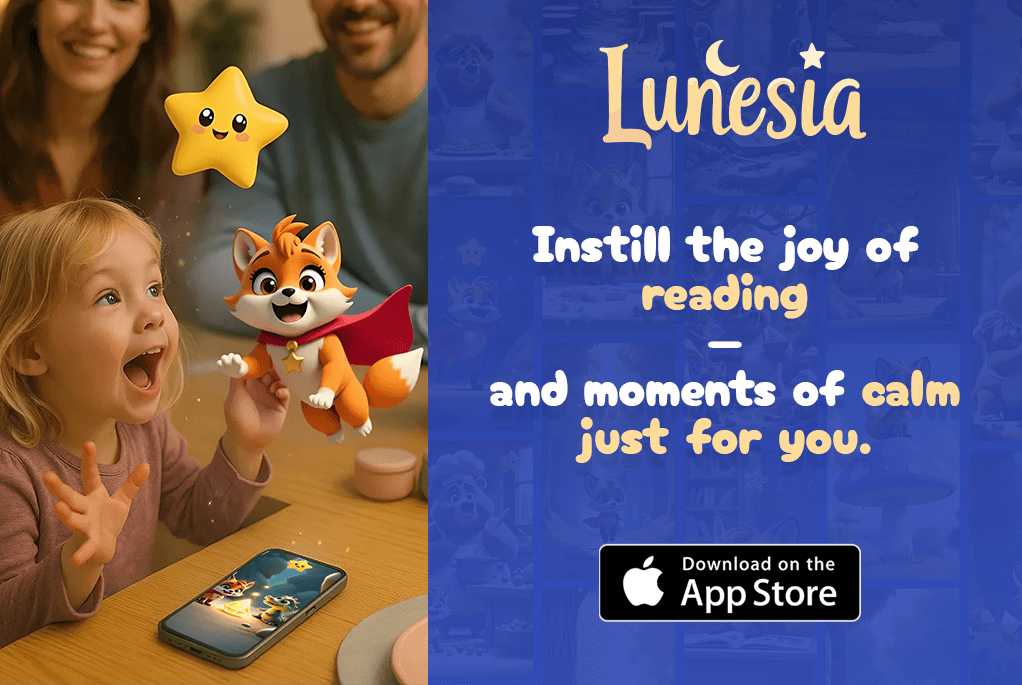Struggling to see your child curl up in bed, trembling with anxiety over imagined monsters or that eerie darkness? You’re not alone, and it’s more common than you think. Nighttime fears can creep into any household and steal precious sleep from both you and your little one. But guess what? You don’t need to endure weeks—or even months—of restless nights or repeated bedtime battles.
There are practical, nurturing, and effective ways to help your child cope with these fears, and I’ve personally tested tons of them over the years. In this article, you’ll discover proven strategies, essential parenting tips, and a step-by-step guide that will help you reclaim peaceful evenings.
So stay with me—your child’s sweet dreams (and yours) are worth the effort! And if you’re looking to supercharge your approach, you’ll see how the Lunesia app can be your secret weapon for tackling nighttime anxiety in the most interactive, child-friendly way possible.
- we’ll dig into why kids develop nighttime fears (like fear of the dark, fear of monsters, or fear of shadows)
- we’ll explore how to calm them in the moment and set the stage for consistent, worry-free bedtime routines
- I’ll share stories of my own “mom fails,” so you can avoid repeating my mistakes
- you’ll learn how not to reinforce these fears and how to avoid turning bedtime into an even bigger challenge
- I’ll walk you through a full tutorial—from establishing a predictable bedtime environment to employing mindful relaxation techniques
- and finally, we’ll touch on references, additional tools, and answer your most burning FAQs
If you’re hungry for real-life tips (and the occasional emoji to keep things fun ✨), you’re in the right place. Let’s jump in and vanquish those nighttime fears once and for all!
Your Child’s Fear Is Real (And So Is Your Frustration)
You might be wondering, “Why does my little one suddenly refuse to go into their bedroom alone?” Believe me, I’ve asked myself that exact same question more times than I can count. My twins went from happily toddling into their room to standing petrified in the hallway, refusing to cross the threshold if the lights weren’t blazing. Talk about an emotional rollercoaster! I used to think, “Is it something I did? Did I let them watch a scary cartoon? Is my bedtime approach making things worse?”
The reality is that fears are a natural part of childhood development, especially once that imagination starts firing on all cylinders around ages 2–3. This is the age when kids are learning about the world through storytelling, make-believe games, and yes, those occasional haunting images they might pick up from media or overhear from older siblings. Suddenly, “there’s a monster under the bed” doesn’t feel so far-fetched to them.
To make matters more interesting, these fears often show up around the time your child is mastering bigger life skills—like potty training or transitioning to a “big kid bed.” You know, all those changes that can feel overwhelming. If your child is pulling out all the stops (crying, pleading, bargaining for “just one more hug”), you’re definitely not alone. But let’s be honest, it can push you to your limit when you’re exhausted and just want everyone to sleep.
Yet even in the depths of frustration, I’ve realized something crucial: acknowledging your child’s fear as real and valid is the first step. Letting them know you understand goes a long way in building trust. You can say, “I see you’re scared. I’ve been scared before too.” If they sense your empathy, it becomes easier for them to follow your guidance toward a peaceful bedtime.
Understanding the Root of Nighttime Fears
Why Your Child Is Terrified of the Dark
I remember the night my daughter first said she saw a scary shape in her closet. I was clueless about what might be triggering her fear of the dark—until I realized that her overactive imagination was turning the simplest shadow into a mythical beast. Children’s brains are creative powerhouses, but that creativity can spiral into frightening scenarios at bedtime.
Key Tip:
- Avoid bright overhead lights that disrupt melatonin production. Instead, opt for a sleep-safe red nightlight to give a comforting glow. I swear by these, especially when the darkness feels suffocating to a child.
- Small anecdote: I once tried a bluish nightlight before I knew better, and my son’s sleep got worse! Turned out the blue hue was stimulating rather than calming. Total fail on my part. Now, red nightlights are my go-to.
Monsters Under the Bed or Hiding in the Closet
I used to roll my eyes at the idea of “monster spray,” until I heard from friends that it could sometimes work. But here’s what I discovered: by playing into the idea that monsters are real enough to spray away, you might actually confirm their existence in your child’s mind. A simpler approach is total honesty: “Monsters aren’t real. Not the closet kind, not the under-the-bed kind.”
Key Tip:
- Don’t watch or read anything even slightly scary before bedtime. Even some Disney classics are a bit intense (side note: Ursula from The Little Mermaid gave my child nightmares for weeks! I’m still a little salty about it).
- Keep the bedtime vibe light and playful with something like Daniel Tiger, CocoMelon, or Mickey Mouse Clubhouseif you really need a pre-bed show. Then, shift to a calm bedtime story that shows there’s nothing to fear.
Shadows and Strange Noises
From AC vents to tree branches scratching the window, children might see or hear any of these and instantaneously imagine a lurking creature. My trick? Grab a flashlight and show them how a simple object can cast a big, scary shadow. Turn it into a game of shadow puppets. Once they see that they can control the shadows, it eases a lot of that anxiety.
Key Tip:
- Walk around the room with your child in the daylight. Let them shine a flashlight on toys, books, furniture, and watch how shadows appear. This hands-on approach demystifies the phenomenon, making bedtime far less intimidating.
Creating a Soothing Bedtime Environment
The Power of Consistency
I’ve realized over the years that a rock-solid bedtime routine is the anchor your child needs—especially when nighttime fears strike. Consistency is so comforting! Think about how you feel when your own sleep routine gets messed up after a late-night Netflix binge. Kids feel that x10.
So what does a great bedtime routine look like?
- Bath Time (if it’s part of your usual schedule)
- Brush Teeth
- Pajamas
- Story Time (consider using the Lunesia app for soothing bedtime stories—more on that soon!)
- A Loving Goodnight Ritual: This can be a hug, a gentle “I love you,” or even a short lullaby
Stick to this pattern, and do your best to keep the same order every night. When your child knows what’s coming next, their mind will focus on the routine steps instead of conjuring up things to worry about.
Optimizing the Sleep Environment
I still recall messing up my first sleep environment for my eldest child. The room was too bright, the TV was on in the living room (and she could hear it!), and the temperature was either too cold or too hot. I didn’t think these little details mattered—until bedtime battles became an every-night occurrence.
Things I learned the hard way:
- Use blackout curtains to eliminate external light sources (particularly helpful if streetlights are streaming in).
- White noise machine or a gentle lullaby track can mask household noises and create a sense of calm.
- Room temperature should be cool but comfortable. I aim for around 68–72°F (20–22°C).
Introducing Lunesia for a Peaceful Wind-Down
Here’s where the Lunesia app becomes a total game-changer. I remember how excited my kids were the first time we used it. Instead of random YouTube videos or hurried bedtime stories, Lunesia offers curated children’s meditations and soothing audio tales tailor-made to tackle nighttime anxiety.
Why Lunesia?
- Interactive Stories: Your child becomes part of the story, which distracts them from their fears.
- Consistency: You can integrate it directly into your nightly routine—press play, and the app leads the wind-down.
I’ve also found it helpful for those nights when I’m too tired to deliver a performance-level bedtime story. Lunesia steps in to do the heavy lifting, and my kids love the variety of tale options.

Concrete Tips to Address Nighttime Fears
1. Encourage Open Conversations—During the Day
During a sunny afternoon, ask, “How are you feeling about bedtime lately?” or “What makes you scared at night?” Kids often have an easier time discussing fears when it’s not right before bed. I remember my son explaining he was worried about a shadow on the ceiling that looked like a face. Once we figured out it was just his nightlight reflecting off a plant, we moved the plant—and the fear magically disappeared.
2. Validate Their Feelings (But Don’t Overdo It)
A good approach is to say, “I understand you’re scared, but you’re safe. Mommy and Daddy are right here if you need us.” Acknowledge their fear without feeding it. Overreactions like “Oh my goodness, that’s so scary! Let’s turn on every light in the house!” only reinforce the idea that there really is something to worry about.
3. Use Comfort Objects
When my daughter was 3, she clung to her stuffed bunny named “Mopsy.” At bedtime, I’d say, “Mopsy keeps you company so you’re never alone.” This small shift helped her feel braver. If your child prefers a blanket or a favorite pillow, incorporate that as a “protector.” Let them hold onto it for reassurance.
4. Reframe the Fear
Kids are imaginative. So use that to your advantage. For instance, if they’re afraid of monsters, rebrand them as friendly or silly creatures. Or, as I mentioned before, politely remind them: “Elmo is called a monster, and he’s so cuddly on Sesame Street! Monsters aren’t real, but if they were, they’d be cute like Elmo.”
5. Praise Their Courage
You can say something like: “I loved how brave you were last night when you heard that noise and didn’t cry out.”Positive reinforcement works wonders. I’ve seen it build my kids’ confidence over time, so bedtime fears gradually lost their grip.
6. Calmly Respond to Night Wakings
When your child does wake up terrified, stay calm. If you rush in with panic, they’ll mirror your emotions. A gentle back rub, a soft “It’s okay, you’re safe,” and leading them back to bed can do the trick. Avoid extended consolations like letting them into your bed, which might validate their fear. Instead, reassure them briefly and encourage them to fall back asleep on their own.
7. Know When They’re Testing You
Sometimes, kids get savvy. They realize that saying “I’m scared” brings more hugs, more kisses, or maybe a chance to sneak into your bed. If you sense they’re faking fear to delay bedtime, firmly but gently reiterate that they’re safe and it’s time to sleep. I’ve been in this scenario before, and it took a few nights of consistent responses, but my child eventually gave up on that particular “stall tactic.”
Practical Strategies I Wish I’d Known Sooner
- Create a Bedtime Chart: List out each step—bath, brush teeth, pajamas, story, hug, lights out. Post it on the bedroom wall. Kids love checking off tasks, and it gives them a sense of accomplishment.
- Schedule “Worry Time”: If your child tends to ruminate on fears, set aside 5–10 minutes in the early evening to discuss any worries. Then say, “We’ve talked about all our worries. Now it’s time to have fun and relax.”
- Role-Play Scenarios: Act out bedtime with dolls or action figures. Let your child see how the toys “handle” fear. This might sound silly, but kids respond to seeing their feelings reflected in make-believe characters.
- Involve Siblings: If you have older kids, they can model bravery. Hearing a big brother or sister say, “There’s nothing to be scared of, come on, let’s read together,” can really help reassure a younger child.
A Simple Table of “Do’s and Don’ts”
| Do | Don’t |
|---|---|
| Offer a gentle nightlight (red hue) | Turn on bright overhead lights that disrupt sleep |
| Acknowledge feelings (“I know you’re scared”) | Use monster sprays or hunts that validate monsters are real |
| Stick to a calm bedtime routine | Vary the bedtime each night, causing inconsistency and anxiety |
| Use story apps like Lunesia for meditation | Rely on scary or overstimulating media close to bedtime |
| Provide quick reassurance at night wakings | Allow them to crawl into your bed if you want to maintain independent sleep (unless co-sleeping is a conscious choice) |
Step-by-Step Tutorial for Peaceful Bedtimes
Let me walk you through an approach I’ve refined through lots of trial and error (and many late nights ☕️).
Step 1: Set Up the Environment
- Dim or turn off overhead lights at least 30 minutes before bedtime.
- Switch on a red nightlight or softly glowing lamp.
- Ensure the room is cool and comfortable.
- Start playing gentle background music or white noise if needed.
Step 2: Engage in a Soothing Pre-Bed Activity
- Encourage some quiet play or read a short (non-scary) book in a cozy corner.
- If your child is active, do a brief relaxation exercise. (For example, have them wiggle their toes, then relax them. Move up the body, wiggling and relaxing.)
- Try a bedtime story from the Lunesia app—my kids adore the interactive elements!
Step 3: Talk About Fears Openly
- Ask your child if anything is bothering them today.
- Acknowledge their feelings without dwelling on them: “I understand. We’ll make sure you feel safe.”
- Suggest one simple coping strategy, like holding their favorite plush or focusing on slow, deep breaths when they feel scared.
Step 4: Nighttime Affirmations
- Whisper simple affirmations: “I am brave, I am safe, and I can sleep peacefully.”
- Feel free to get creative and let them repeat the affirmation. Kids love chanting along!
- Keep the tone playful, not overly serious.
Step 5: Tuck-In and Reassure
- When you tuck them in, do your usual routine—kiss, hug, or any short ritual.
- Remind them gently: “I’m right here if you need me, but you’re safe in your bed.”
- Leave the room with a confident demeanor. If you look worried, they’ll worry too.
Step 6: Handle Nighttime Wakings Calmly
- If your child wakes up crying, go in calmly, keep lights dim, and reassure.
- Limit the interaction to a brief, comforting phrase: “I love you; it’s time to sleep.”
- Gently guide them back to bed if they’ve wandered out.
Step 7: Celebrate Morning Success
- In the morning, praise them: “You did great sleeping through the night!”
- If they struggled, acknowledge it but end on a positive note: “I know it was tough, but you tried your best. Tonight, we’ll do even better.”
- This sense of accomplishment builds momentum for the next night.
Resource Roundup: Where to Go for Extra Help
Below are some fantastic references if you’re craving more insights or looking for different perspectives on child fear management, nighttime anxiety, and child sleep solutions.
- Zero to Three
- Why It’s Helpful: A research-based resource that covers everything from toddler behavior to early childhood development.
- My Take: Their articles on separation anxiety and fear of the dark gave me great evidence-based strategies.
- HealthyChildren.org (The American Academy of Pediatrics)
- Why It’s Helpful: Expert-backed articles and videos on child health and psychology.
- My Take: If you want official guidelines or more medical perspectives, this is a top-notch spot.
- Lunesia App (yes, I’m referencing it again!)
- Why It’s Helpful: Offers interactive bedtime stories, guided relaxation, and can be personalized to your child’s preferences.
- My Take: Has personally saved my sanity on nights when my creativity well ran dry.
You could also consider reading parenting books like The Whole-Brain Child by Daniel J. Siegel and Tina Payne Bryson for more in-depth neuroscience and strategies.
Comparing Lunesia with Other Bedtime Solutions
Curious how Lunesia stacks up against common alternatives? Check out this quick comparison table:
| Feature | Lunesia | Generic Story App | Traditional Nightlight |
|---|---|---|---|
| Interactive Meditation | Yes – child-friendly guided sessions | Usually no | No – just a light |
| Customizable Content | Yes – tailors stories by theme/age | Limited – some have preloaded tales | Not applicable |
| Engaging for Older Kids | Yes – advanced storylines, relaxing music | Limited – might be too simple | N/A (just illumination) |
| Ideal for Nighttime Anxiety | Absolutely – designed for relaxation | Partially – can be too stimulating | Helps slightly by brightening the room |
From my experience, the biggest advantage with Lunesia is the built-in guided meditations that help reframe bedtime as a calming, magical time rather than a source of stress or fear.
Let’s Wrap It Up
We’ve covered a lot of ground here—everything from common nighttime fears like fear of the dark, fear of monsters, and fear of shadows to environment optimization, bedtime routines, and the critical aspect of handling night wakings calmly. Remember, consistency and empathy go hand in hand. I’ve had my fair share of mistakes—like using bright lights or letting my child watch a borderline scary movie too close to bedtime. But I’ve also learned that a gentle, well-structured approach, supplemented by cool tools like the Lunesia app, can transform your evenings from tearful battles into quiet, restful nights.
Trust me, you’re not alone in this journey—and with patience, understanding, and the right resources, your child’s bedtime can become a peaceful, cherished part of the day. Now it’s your turn: What step will you take tonight to ease your child’s fears? Will you talk about it over dinner, introduce a new bedtime story, or test out a meditation session? You have the power to help your little one feel secure and drift off to dreamland with a smile. Let’s make it happen! ✨
FAQ
What If My Child Suddenly Starts Talking About Fears at Age 8 or 9?
Even older kids can develop nighttime fears, often triggered by stress at school, scary news stories, or even peer discussions about spooky stuff. Validate their worries—just like you would for a younger child—but encourage more “grown-up” coping techniques, such as journaling before bed or using a guided relaxation track on the Lunesia app. You can also talk more openly about how their imagination works. Sometimes older children respond well to logical explanations and reassurance that their thoughts, not outside forces, are fueling the fear.
Should I Ever Let My Child Sleep in My Bed If They’re Terrified?
That’s a personal decision. Some families find co-sleeping beneficial; others prefer independent sleeping arrangements. But if your goal is to maintain independent sleep, bringing them into your bed might reaffirm that there’s something to fear in their own room. A more balanced approach might be: “I’ll stay with you for a few minutes to help you calm down, but then it’s time to sleep in your own bed.”
How Can I Tell the Difference Between a Genuine Fear and a Bedtime Stall Tactic?
Observe your child’s behavior. If they’re genuinely scared, you’ll typically see genuine distress—tears, trembling, or clinging. If it’s a stall tactic, they might shift gears quickly (crying one moment, then asking for a snack the next). Consistency is key: give a quick, calm reassurance, then guide them back to bed. Over time, they’ll learn that “I’m scared” doesn’t equal extra playtime.
Can Nighttime Fears Be a Sign of an Underlying Anxiety Disorder?
Mild nighttime fears are normal. However, if your child’s anxiety is severe, prolonged, and affects daytime functioning, it’s wise to consult a pediatrician or child psychologist. Extreme cases might suggest an anxiety disorder. Typically, though, these developmental fears peak between ages 3–6 and gradually fade.
Why Are Red Nightlights Better Than White or Blue Nightlights?
Blue or white lights can suppress melatonin (the hormone that regulates sleep) more effectively, making it harder for your child to settle down. Red or orange lights have a longer wavelength and minimal impact on melatonin production. They provide enough visibility for reassurance without disrupting sleep cycles as much.
What If My Toddler Is Already Two and Not Sleeping Due to ‘Fears’?
If your child is under 2, it’s often not real fear but things like separation anxiety or the need for certain sleep associations (like being rocked or fed to sleep). In that case, reassess your bedtime routine, check for overtiredness, and see if you can ease them into more independent sleep gradually. However, if your child is around 2.5, they might indeed be experiencing the onset of imaginative fears. In that case, all the tips here still apply—just be extra patient because toddlers can’t always articulate what’s scaring them.
How Does the Lunesia App Help With Nightmares or Bad Dreams?
Lunesia offers guided and calming stories that can disrupt negative thought patterns before sleep. It also provides fun and relaxing bedtime content, which can help replace scary images in a child’s mind. If your child has woken up from a bad dream, listening to a short calming track can help them refocus on something pleasant. Think of it as a mini mental reset right before drifting back off.
Now that you’ve got a treasure trove of child fear management insights—plus a load of personal anecdotes from my own bedtime battles—I hope you’ll feel more confident and less stressed. You’ve got this, my friend! And remember: a child’s nighttime fear doesn’t last forever. With the right approach, it can be a short-lived phase that you both come out of stronger. Now, go make those bedtime routines fun, consistent, and fear-free! ✨




